I have decided to embark upon an exploration of 12 nutrient dense opportunistic plants (in twelve separate posts spanning 12 days) that are freely available, often grow all over the place, are often more nutritious than store bought produce and offer benefits such as optimizing the function of the immune system.
We live in times when transnational oligarchic interests are seeking to weaponize CBDCs, Digital ID, Social Credit Scores and other technocratic control mechanisms to be able to cut you off from your hard earned money if you refuse to obey corporate and government edicts. This is making some concerned about if they will be able to access food to survive in the worst case scenario.
Some people think investing in diversified hard assets (gold/silver etc), cash, non-perishable food stores and cryptocurrency are the answer, but those things do not have intrinsic value (and/or they can be taken from you) thus their value in a survival situation pales in comparison to foraging, food cultivation and preservation, knowledge, skills and experience.
Knowledge, skills and experience related to food cultivation, foraging and preservation cannot be stolen from you, and thus these things have intrinsic value as they are applicable and accessible in any and all situations.
In the spirit of helping you cultivate knowledge, skills and experience that have intrinsic value I share the following.
It is my hope that the information in this article (and the following 11) will help you to realize that you are surrounded in a bounty of food and medicine gifted to us by Mother Earth. Even in a worst case scenario we are capable of foraging for nutrients to care for our bodies without access to money.
In the modern western world we are conditioned to think of plant identification and foraging skills as some kind of ‘obscure hobby’ for ‘crazy peppers’, ‘hippy herbalists’ and/or ‘poor people that can’t afford groceries’ but if you go back only a few centuries, these were skills that our ancestors cultivated from a young age and used in their day to day lives. These skills gave our ancient ancestors a form of resilience and True Wealth which many of us now lack in our lives. I aim to help offer keys for those that are interested and motivated to remedy this modern day ‘poverty of plant knowledge’ so they can take decisive steps to be able to access the same wealth and resilience of our ancient ancestors (regardless of what situation or challenge one is facing).
Mother nature's medicine cabinet is always open to us. All she asks of us for her gifts is that we respect her and that we give back to her in reciprocity. We can respect the abundant gifts she offers us by practicing something called "The Way of The Honorable Harvest".
In doing so endless gifts of medicine, food, and beauty can continue to flow and be available to us and countless other beings.
"Weeds" get a bad rap in the modern world, these are misunderstood, judged, dismissed, and sometimes loathed plants that are very effective at growing without any care from humans (often in a diverse array of soils and climates). Many "weeds" are nutrient accumulators and nature’s soil repair mechanisms, showing up in disturbed areas and places that used to be mature ecosystems (but are now areas inhabited by humans and their urban suburban sprawl). These plants are great at pulling up minerals and nutrients from deep in the soil and growing fast to, break up tough soils with their strong roots, turn those nutrients into bio-matter that can protect and nourish the top layer of soil (allowing a succession of more diverse and longer lived plant species to eventually take up residence and repair the ecosystem that humans have disrupted or destroyed). Many of these opportunistic nutrient sequestering plants (that grow without any human care or attention) are edible and can be included in our daily diet for both nutritional and medicinal reasons.
For the next 12 days (once per day) I will share information on a plant that is considered as 'a weed' which is also nutritious and offers medicinal benefits.
I see no better place to start then the humble dandelion. Many fastidious lawn groomers see this plant as their worst enemy yet this plant offers many gifts to those who share its growing space. Enter the Dandelion:
Day One: Dandelion
A ‘weed’ that we all know because it takes over in lawns, gardens and even pops in in cracked sidewalks and pavement! You may feel compelled to dismiss this plant as troublesome, but it can be used as an excellent food and herbal medicine. According to a publication in Cambridge University Press, it is a source of various nutrients and biologically active substances. In addition, its roots and leaves contain vitamins (complexes A, K, C and B), minerals (calcium, magnesium, potassium, zinc and iron), micronutrients, fibers, lecithin and choline.
Both the root and greens are packed with health-promoting properties and can be used to make everything from dandelion tea to super-nutritious salads.
Historical Uses:
Just like other roots, such as burdock and ashwagandha, dandelion root also has a rich history of use in traditional medicine. In fact, the origins of dandelion as a natural remedy can be traced all the way back to 659 B.C. in ancient China. It was also used in Arabic, Welsh and European medicine and was eaten raw or made into a juice or tonic.
Traditional uses of the dandelion ranged from promoting better digestion to healing the liver. Some Native American tribes chewed on dandelion root to relieve pain, while others steamed the leaves and applied topically to ease sore throats
Habitat/Distribution:
Health Benefits of Dandelion :
The plant has properties such as immunomodulator, digestive stimulant, prebiotic, insulin stimulant, anti-inflammatory, antiangiogenic, antineoplastic and demulcent.
Dandelion can act as a digestive aid thanks to its mild laxative function and the power to balance the natural flora in the intestines. It is also very cleansing to the liver and kidney by clearing out waste, salt and excess water. Its richness in antioxidants helps regenerating the body and combat illnesses like cancer. Regulates blood sugar, blood pressure and lowers cholesterol.
The ultimate detox and healing weed! Dandelion greens are nutritious all on their own, but the roots are best for a naturally detoxifying tea. As noted above, dandelion root purifies the liver, and it also contains potassium, making this elixir the perfect hangover cure. You won’t need the leaves for this brew – just clean the roots and place them in boiling water. Add herbs or a stick of cinnamon for additional flavor.
Some of the many health benefits of dandelion:
1. Promotes and Stimulates Digestion
Dandelion acts as a mild laxative that promotes digestion, stimulates appetite, and balances the natural and beneficial bacteria in the intestines. It can increase the release of stomach acid and bile to aid digestion, especially of fats.
Some studies show that dandelions help increase Lactobacillus and Bifidobacterium, two of the most common species of bacteria found in probiotics that are well-associated with gut health. Instead of taking daily probiotics, you can add dandelions to your daily health regime as well. It might help with problems like bloating and gas, common problems that happen when you have digestion problems.
2. Prevents Water Retention in the Kidneys
This weed-like superfood is a natural diuretic, which helps the kidneys clear out waste, salt, and excess water by increasing urine production and frequency of urination.
In French, it is called pissenlit, which roughly translates to ‘wet the bed.’ This inhibits microbial growth in the urinary system and prevents urinary tract infections.
Dandelion also replaces some of the potassium lost in the process.
In a study conducted in 2009, high-quality fresh dandelion leaf hydroethanolic extract was given to volunteer subjects. Results showed that the urine output and frequency increased in the two out of three instances dandelion extract was ingested.
Dandelion has been shown to improve hepatic function by detoxifying the liver and reestablishing hydration and electrolyte balance. It also increases the production and release of bile.
A laboratory study on mice showed this medicinal plant’s ability to slow down the progress of carbon tetrachloride-induced liver fibrosis or scarring.
4. Boosts Antioxidant Activity
Every part of the dandelion plant is rich in antioxidants, which prevents free radicals from damaging cells and DNA, slowing down the aging process in our cells. It is rich in vitamin C and vitamin A as beta-carotene and increases the liver's production of superoxide dismutase.
What is superoxide dismutase? This is an enzyme that speeds up or catalyzes the breakdown of the oxidative stress-causing superoxide by-product.
5. It helps prevent/fight Cancer
The ability to combat cancer is not a claim made lightly, but dandelion seems to show promise in study after study after study. Dandelion may slow cancer's growth and prevent it from spreading.
The leaves are especially rich in antioxidants and phytonutrients which combat cancer. Dandelion root extract, on the same note, has shown its ability to induce apoptosis or cell death in prostate and pancreatic cells.
6. Helps Regulate Blood Sugar Levels
Recent animal studies show dandelion helps regulate blood sugar and insulin levels. Most of this is done through its ability to control lipid levels and stimulate the pancreatic cells to produce more insulin when needed.
7. Aids in the Management of High Blood Pressure
As a natural diuretic, dandelion increases urination which then lowers blood pressure. The fiber and potassium in dandelion also help regulate blood pressure.
8. Reduces Cholesterol Levels
Animal studies have shown how dandelion lowers and controls cholesterol levels while improving cholesterol ratios by raising HDL.
Dandelion increases bile production and reduces inflammation to help with gallbladder problems and blockages.
10. Fights Inflammation with Its Antioxidant Properties
Dandelion contains essential fatty acids, antioxidants, and phytonutrients that all reduce inflammation throughout the body. These can relieve pain and swelling.
Studies also show dandelion boosts immune function and fights off microbes and fungi.
Heals cuts and minor injuries
Dandelions are known for healing minor skin injuries like cuts, scrapes, and minor burns. It helps skin regenerate while nourishing and moisturizing chapped and dry skin. It’s the perfect combination, and since it’s believed to combat infections, you can use it in place of triple antibiotic cream.
Generally, the flowers are used for skin issues, and the most common preparation is a simple dandelion-infused oil. (Learn how to make an infused oil from any plant here.)
Edible parts of Dandelion:
Leaves - raw or cooked. When used in salads, they are rather bitter, though less so in the winter. Tender young leaves are considerably less bitter than older leaves. The leaves are often blanched (by excluding light from the growing plant) before use. This will make them less bitter, but they will also contain less vitamins and minerals.
Root - raw or cooked. Bitter. A turnip-like flavour. Flowers - raw or cooked. A rather bitter flavour, the unopened flower buds can be used in fritters and they can also be preserved in vinegar and used like capers. Both the leaves and the roots are used to flavour herbal beers and soft drinks such as "Dandelion and Burdock". The roots of 2 year old plants are harvested in the autumn, dried and roasted to make a very good coffee substitute. It is caffeine-free. A pleasant tea is made from the flowers. They are also used to make wine - all green parts should be removed when making wine to prevent a bitter flavour. The leaves and the roots can also be used to make tea.
How to Pick Dandelion Root and Leaves:
It has been eaten for thousands of years as food and medicine to help treat anemia, scurvy, skin problems, blood disorders, and depression.
If you collect them wild, try to choose ones you know have not been subjected to pesticides, fertilizers, and other chemicals.
Dandelion leaves, flowers, and roots are all edible. They have a slightly bitter flavor that can be minimized by harvesting them in the fall or spring.
The young leaves are more tender and less bitter, making a great addition to raw salads. Cooking dandelion cuts the bitter flavor of both the leaves and the roots.
You can start by drinking a cup of dandelion root coffee or roasted dandelion root a day to give your body time to adjust. Then, increase your intake to two to three cups a day.
It is also possible to collect dandelion seeds and sprout them to create tasty and super nutritious edible green spouts for adding to salads or sandwiches. http://atomicshrimp.com/post/2011/04/25/Experiments-With-Dandelion-Seeds?fbclid=IwAR25oZlcG6XN2250SBlwGoo6YPTs-uSSlpLx8c04r5kSfHJgdM-TWxftuG0
Here are some fun ideas for enjoying/preserving dandelion
Dandelion Soup : https://www.almanac.com/recipe/dandelion-soup
(adjust to personal taste and add other seasonal ingredients available)
Dandelion Pesto : https://www.almanac.com/recipe/dandelion-pesto
Dandelion Jelly : https://www.homestead-acres.com/how-to-make-dandelion-jelly/
Fermented dandelion buds (aka "dandelion capers") : https://hungerandthirstforlife.blogspot.com/2010/05/wild-about-dandelion-buds.html?fbclid=IwAR1UygAwbQOV9NLT9nHWTujNwO1Y4y2P5btlsbne9jY5x00svwCUJHm1Wkw
LEBANESE DANDELIONS WITH CARAMELIZED ONIONS (HINDBEH) : https://foragerchef.com/lebanese-dandelions-with-caramelized-onions-hindbeh/
Dandelion Wine : https://www.thespruceeats.com/how-to-make-dandelion-wine-1327932
Dandelion Root Dosage:
There is no approved recommended dosage for dandelion extract in the U.S., but there are recommended daily dosages in Europe:
• Dried dandelion extract - .75-1 g
• Fresh dandelion root - 2-8 g
• Fresh root extract - 1-2 tbsp
• Dandelion tea infusion - 1 tbsp chopped root soaked in ½ cup of hot water for 20 mins.
• Dandelion root powder - 3-4 g powder dissolved in ½ cup of hot water
How to Make Dried Dandelion Root (for making tea later)
Get dandelion root and leaves.
Soak your dandelion leaves and roots in water for a few minutes, then rinse. Cut them into small bits.
Roast for an hour at 200° F for 60 minutes to make roasted dandelion roots and leaves. Cool them down before storing in an airtight container.
When you’re ready to drink, just take a few teaspoons and add to hot water. Enjoy your dandelion root 'coffee' or tea!
I hope you found this information helpful and will try foraging for some dandelions and find peace of mind in the knowing that you are surrounded in food and medicine.
If we learn from Mother Nature and accept her open hand we can thrive and nurture our bodies in any and all situations (while staying guided by integrity and love).
We can align our wealth and health with the health and wealth of the living Earth and through merging with her regenerative capacity and inherent abundance we can become irrepressible. We are the ones we have been waiting for.


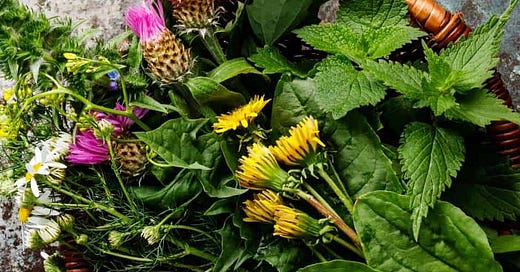



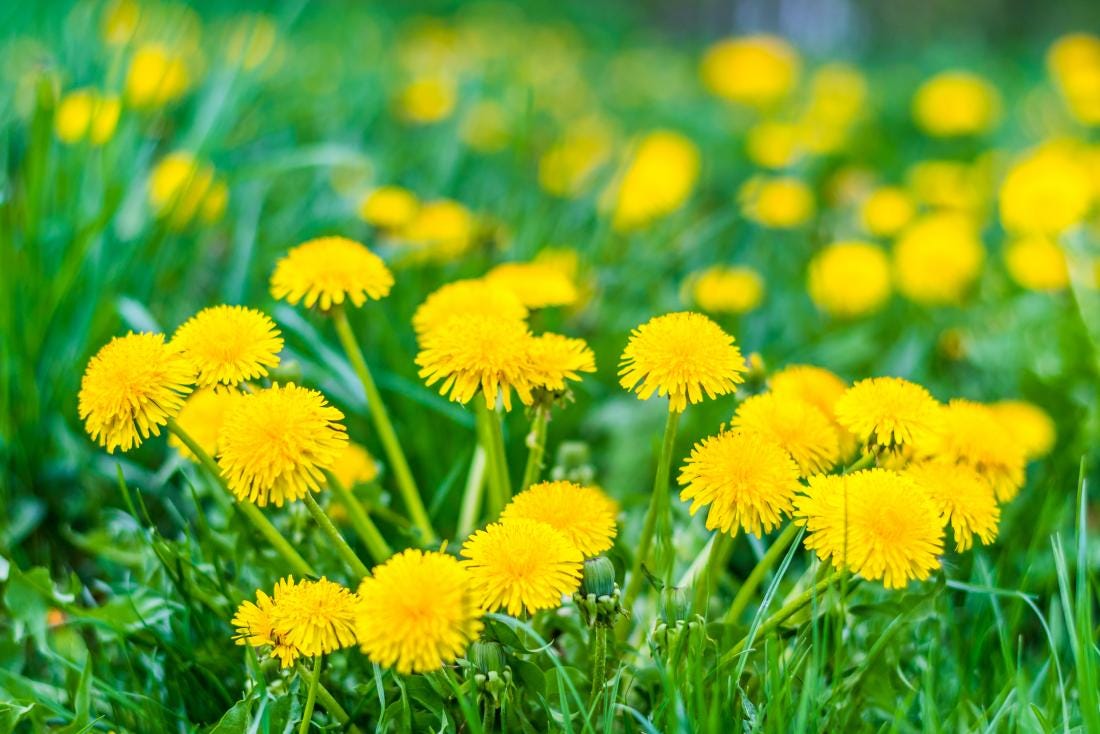
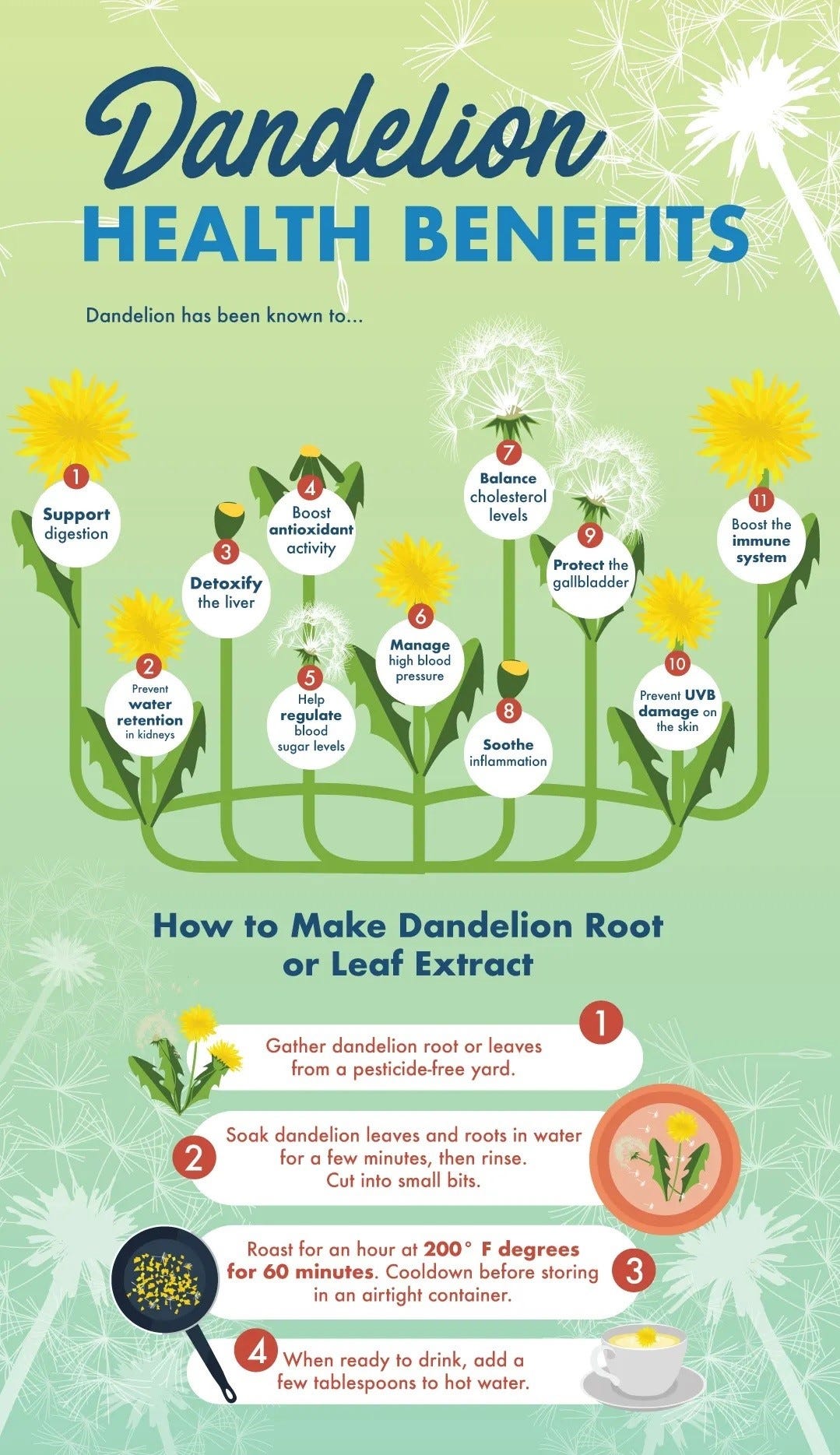

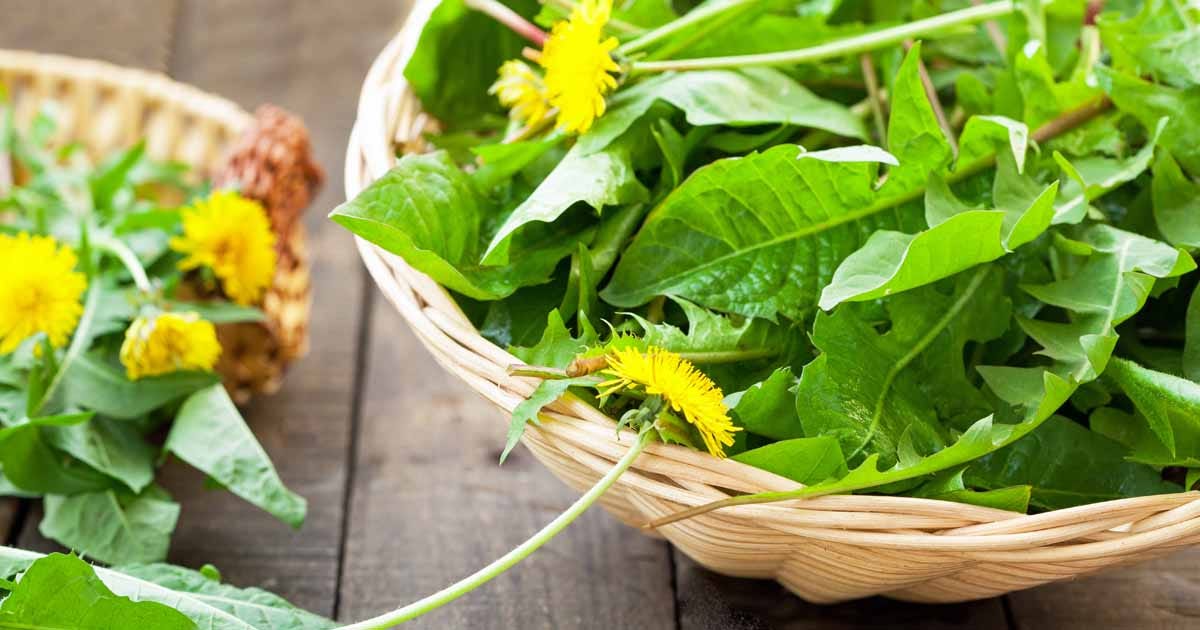
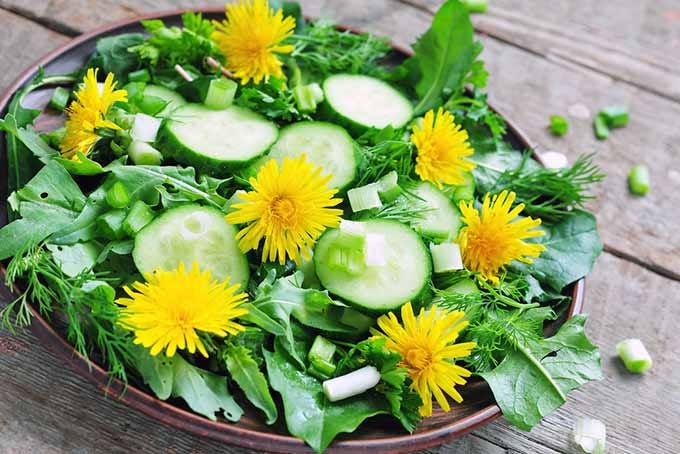
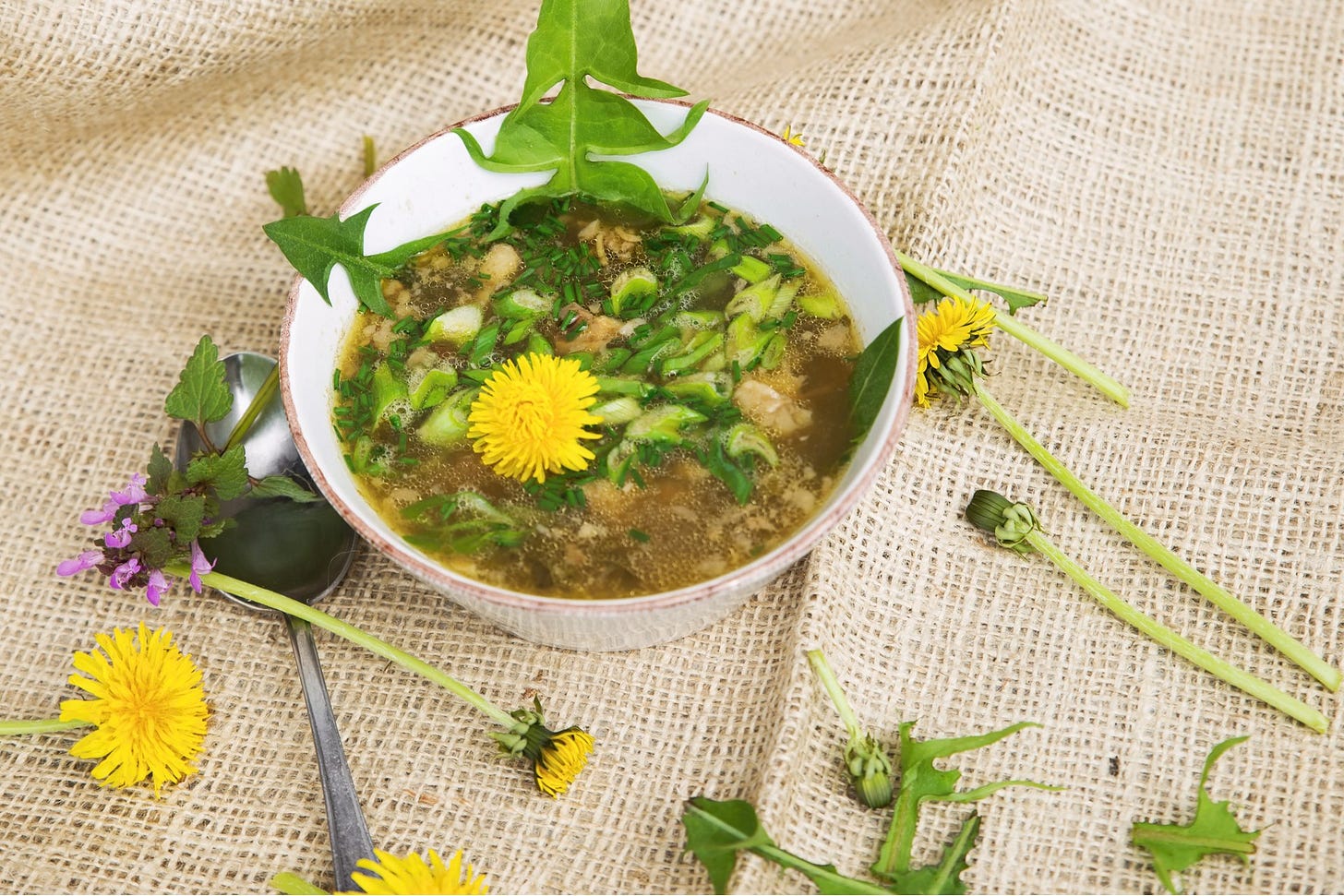
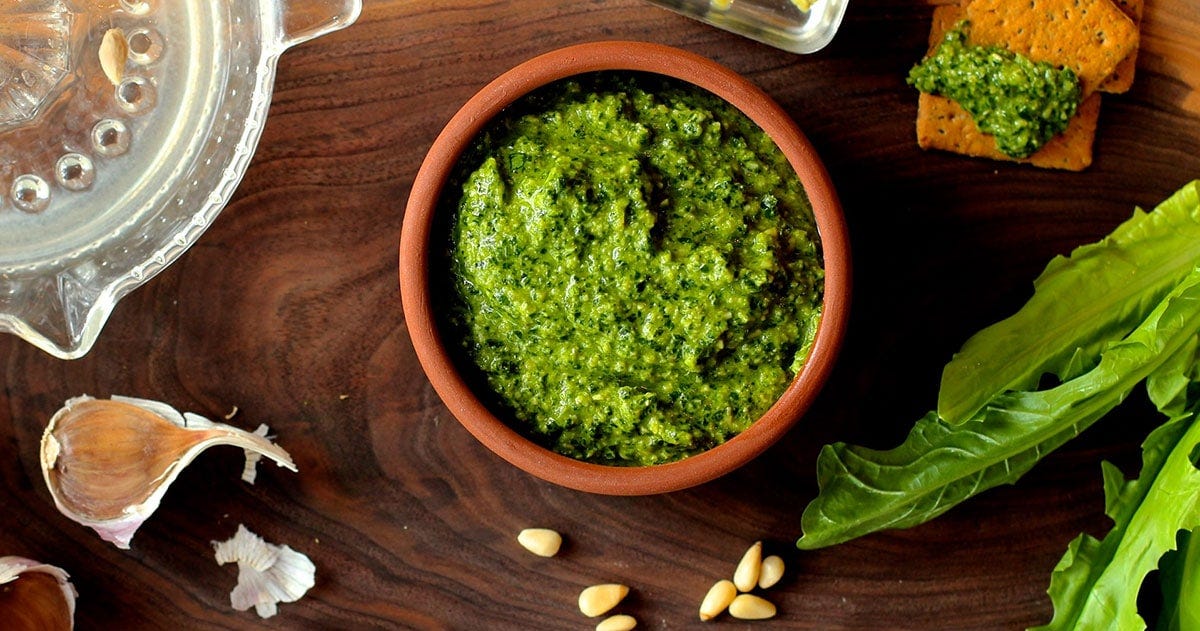
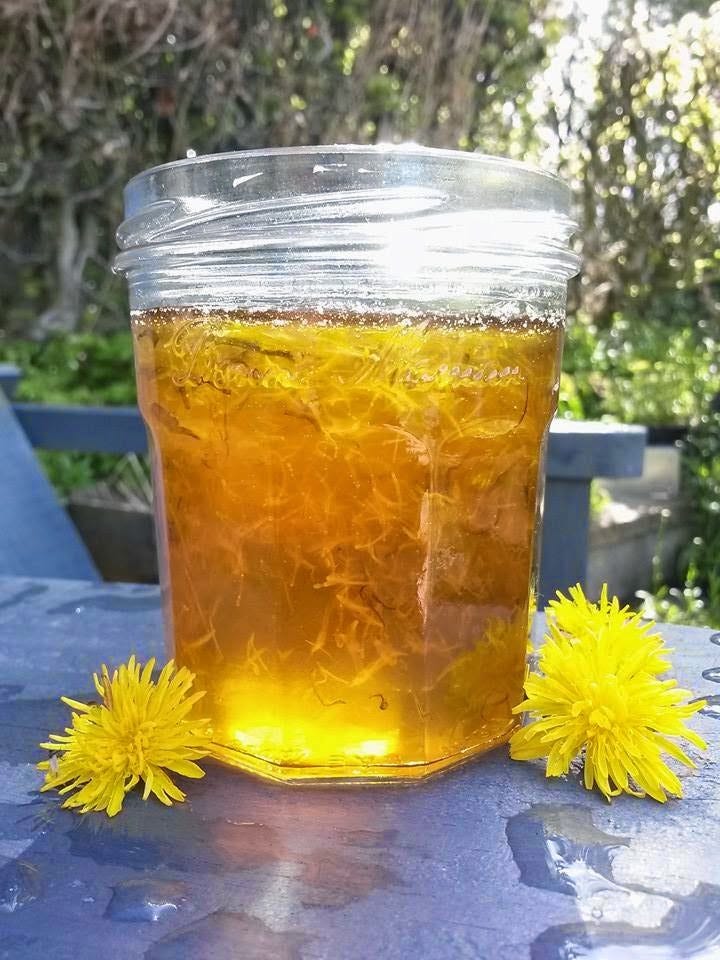
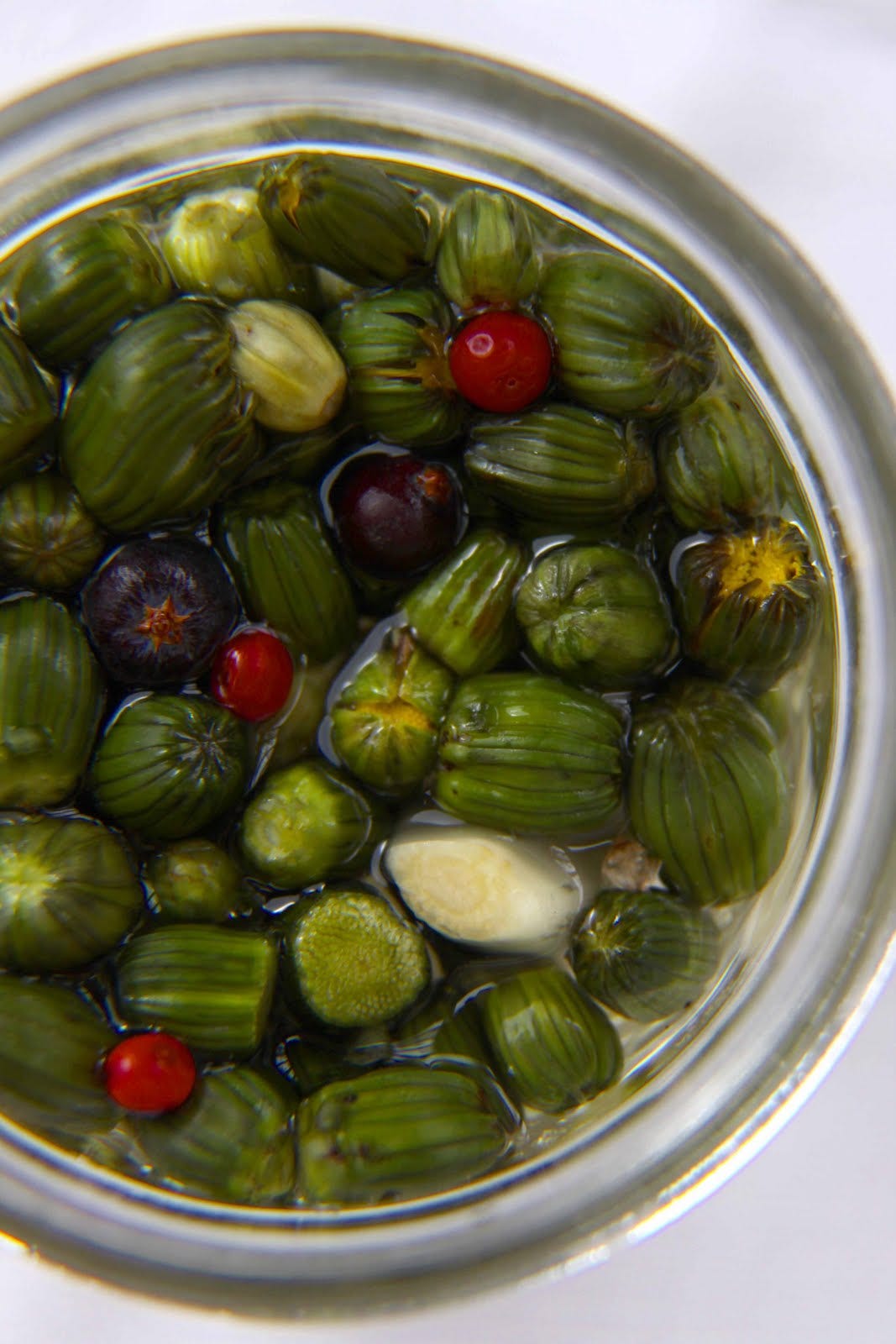
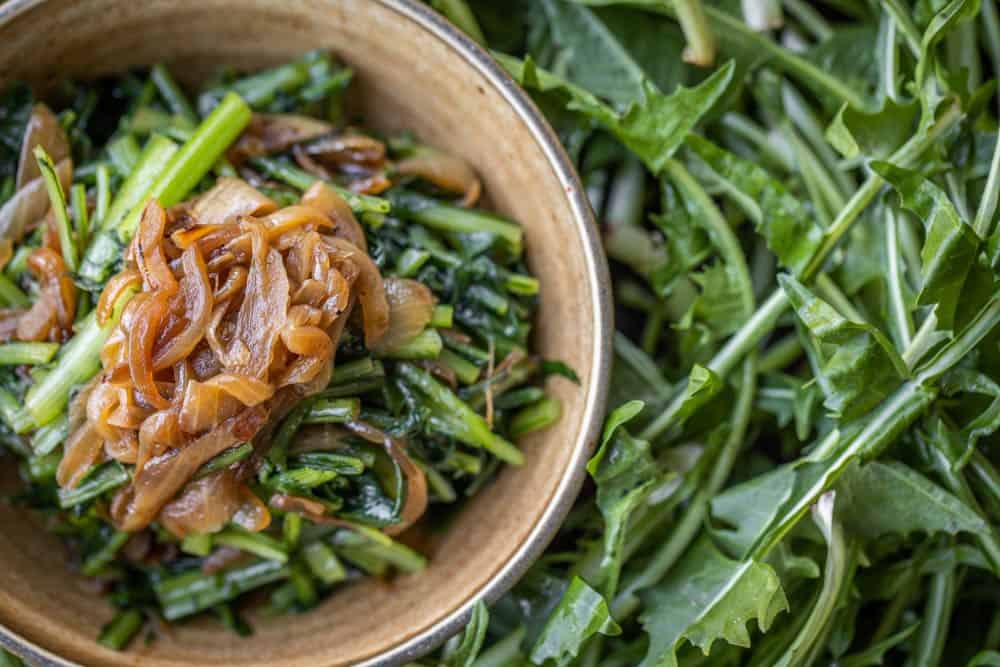
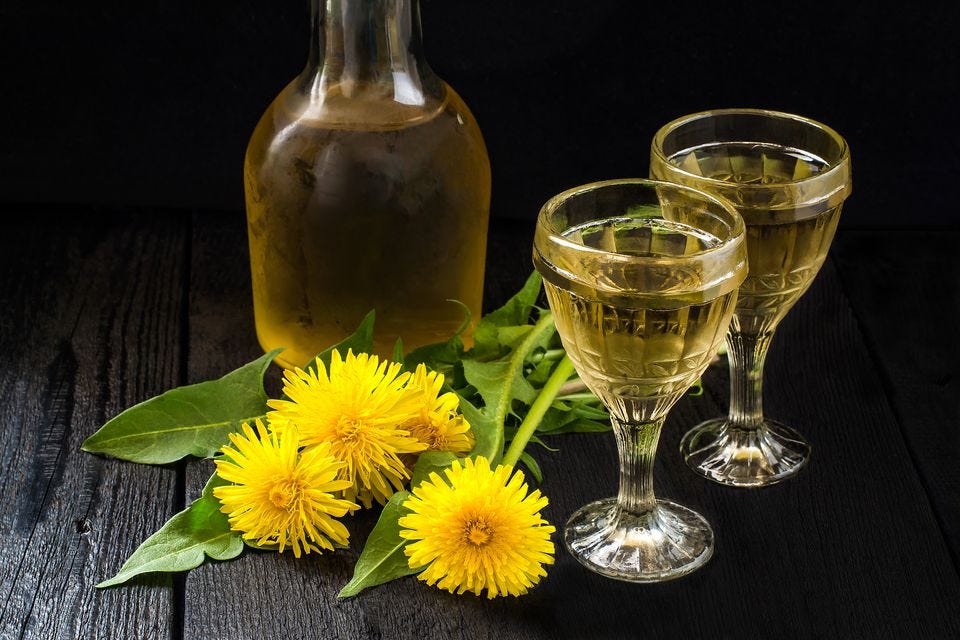
Another great article, Gavin! You're so right about these "weeds" being there for us if the you-know-what hits the fan as predicted. It's interesting how so many of the drought-resistant "weeds" are so seriously healing - Dandelion, Yarrow, Red Clover, Mullein, just to name a few. I'm guessing Yarrow will be included in your series. :)
My Dandelion story is that I used to go to the movies a lot and of course had to have popcorn (I did make my own, with ghee and sea salt!) But my stomach would always ache afterwards. One day, on a lark, I took a dropper of Dandelion root tincture before eating the popcorn and voila! No stomachache.
I don't drink coffee but I love to drink Chaga and Dandelion root with some milk and maple syrup. Sometimes I jazz it up with cacao.:)
I love weeds! :)
Thank you Gavin! I'm inspired to start a group in my community based on these 12 articles, meet weekly, share and learn together.